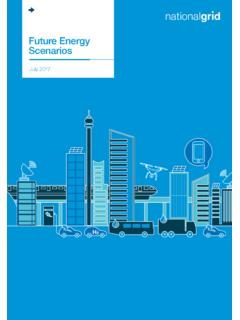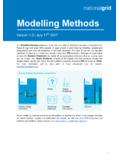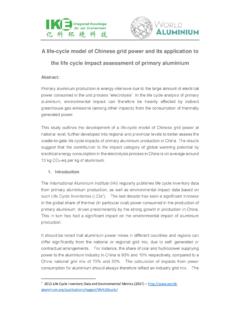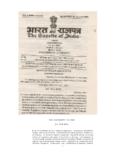Transcription of Future Energy Scenarios in five minutes - National …
1 CCSJuly 2017 Future Energy Scenarios in five minutesAbout FESWhat are the Future Energy Scenarios (FES)? They are a range of credible pathways for the Future of Energy out to 2050. They reflect the possible sources of, and demands for, gas and electricity in the Future , and the implications of this for the Energy do we make them? The Scenarios are used within National Grid for network and operability planning and developing other forward-looking views such as charging projections. The Scenarios are also used across the Energy industry, driving debate and decision do we make them? Every year we engage hundreds of stakeholders through workshops, bilateral meetings and webinars.
2 The information we gather supports and inputs into our detailed summaryAs System Operator (SO), we are perfectly placed to be an impartial enabler, informer and facilitator. The SO publications that we produce every year are intended to be a catalyst for debate, decision making and change, and provide transparency to the wider industry. The starting point for our SO publications is the Future Energy Scenarios (FES). The FES is published every year and involves input from stakeholders across the Energy industry. This year we have enhanced our stakeholder engagement activities and we consulted 391 organisations, increasing our engagement from 362 in 2016. The Scenarios are based on the Energy trilemma (security of supply, sustainability and affordability) and provide credible pathways for the Future of Energy out to 2050, capturing the uncertainties regarding the Future of Energy for Great Britain (GB).
3 It is hard to have missed the significant amount of change on economic, political and technological fronts over the past year s analysis shows us electric vehicles (EVs) could drive large increases in peak demand if we continue to see the sharp uptake past the 2030s and if there is no management of when charging occurs. Decarbonising heat remains an area that is difficult to progress and our Scenarios cover a range of approaches to heating, from incremental to fundamental changes. There is no one solution for the heating dilemma but in our Two Degr ees, which meets 2050 targets, the use of gas boilers declines considerably by 2050 and is overtaken by heat pumps, supported by improved house heat see an increasing diversity of generation sources becoming available and technology driving growth in the Future .
4 Innovation in information communication technology (ICT) is allowing new opportunities to emerge such as residential and commercial Energy generation, and smart devices that use and provide data to communicate quicker and easier than ever Grid has an important role to play in leading the debate on the Energy revolution across the industry and working with our stakeholders to ensure that we have a safe, secure and reliable Energy are the Future Energy Scenarios ? Why and how do we make them?Will we all be driving electric cars in the Future ?391 Number of organisations engagedThe Scenarios are based on the Energy trilemmaJuly 2017 01 Key messagesThe total amount of renewable generating capacity made up 34% of total installed capacity in 2016.
5 This could increase to as much 60% by 2016, installed capacity from distributed generation reached 26 GW. Looking forward to 2050, this could increase to a total of 93 are rapid changes in technologies and approaches such as battery storage, electric vehicles and demand side response. electricity storage capacity could grow rapidly to almost 6 GW by facilitation and investment will be required to achieve an agile, coordinated and accessible Energy market that delivers value for GWPotential amount of electricity storage by GWPotential increase in distributed generation capacity by An Energy system with high levels of distributed and renewable generation has become a reality.
6 This growth is set to continue, increasing the complexity of operating a secure and cost-effective Energy system. 2. New technologies and evolving business models are rapidly transforming the Energy sector. Market and regulatory arrangements need to adapt swiftly to support a flexible Energy system with an increasing number of Energy Scenarios in five minutes 02 July 2017 03 Key messagesElectricity peak demand could be as high as 85 GW in 2050, compared to around 60 GW could be as many as 9 million electric vehicles by 2030. Without smart charging this could result in an additional 8 GW of demand at peak supplies more than twice as much Energy annually as electricity today and could still provide more Energy than electricity in order to meet the 2050 carbon reduction target, decarbonisation of heat needs to pick up pace now.
7 Gas will continue to play an important role in this transition and beyond with new technologies and the potential use of number of electric cars by electricity demand has the potential to increase significantly and the shape of demand will also change. This is driven initially by electric vehicles and later on by heat demand. It will require a range of solutions to deliver best value for consumers, including a coordinated approach across the whole system; investment in smart technologies, transmission and distribution infrastructure; and commercial approaches such as consumer behaviour Gas is critical to security of supply now and as Britain continues the transition to a low carbon Future .
8 It will have a long-term role as a flexible, reliable and cost-effective Energy source favoured by many consumers. GasProvides twice as much Energy as Energy Scenarios in five minutes 04 July 2017 05 Our scenariosThe 2017 scenario matrixTwo Degr ees has the highest level of prosperity. Increased investment ensures the delivery of high levels of low carbon Energy . Consumers make conscious choices to be greener and can afford technology to support them. With highly effective policy interventions in place, this is the only scenario where all UK carbon reduction targets are DegreesIn a Consumer Power world there is high economic growth and more money available to spend.
9 Consumers have little inclination to become environmentally friendly. Their behaviour and appetite for the latest gadgets is what drives innovation and technological advancements. Market-led investments mean spending is focused on sources of smaller generation that produce short- to medium-term financial PowerIn Steady State business as usual prevails and the focus is on ensuring security of supply at a low cost for consumers. This is the least affluent of the Scenarios and the least green. There is little money or appetite for investing in long-term low carbon technologies, therefore innovation StateIn Slow Progression low economic growth and affordability compete with the desire to become greener and decrease carbon emissions.
10 With limited money available, the focus is on cost-efficient longer-term environmental policies. Effective policy intervention leads to a mixture of renewable and low carbon technologies and high levels of distributed ProgressionProsperityMore money availableLess money availableGreen ambitionMore focusLess focus Steady StateA world focused on security of supply and short-term thinkingTwo Deg r e esA world where environmental sustainability is top prioritySlow ProgressionA world focused on long-term environmental strategyConsumer PowerA world which is relativelywealthy and market drivenFuture Energy Scenarios in five minutes 06 July 2017 0720162020202120222023202420252026202720 2820292030203120322033203420352036203720 38 2039 Maximum potential by 2050 Heating1







